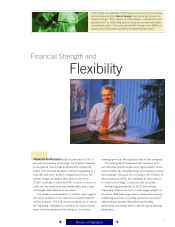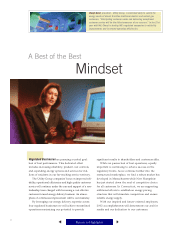Eversource 2001 Annual Report Download - page 18
Download and view the complete annual report
Please find page 18 of the 2001 Eversource annual report below. You can navigate through the pages in the report by either clicking on the pages listed below, or by using the keyword search tool below to find specific information within the annual report.
Additionally, a prime determinant of where NU performs
within the aforementioned 2002 earnings range is the perfor-
mance of the company’s competitive energy subsidiaries. NU
expects revenues from its competitive energy subsidiaries to
exceed $3.8 billion in 2002. Much of that increase over 2001 is
the result of Select Energy, Inc.’s (Select Energy) acquisition of
Niagara Mohawk Energy Marketing, Inc. (NMEM) in late
November 2001 for approximately $31.7 million. That business
was subsequently renamed Select Energy New York, Inc. (SENY).
In 2001, Select Energy’s profits from its wholesale electric sales
were reduced by its obligation to serve 50 percent of CL&P’s stan-
dard offer service load at below market rates. Select Energy’s oblig-
ation to serve that load, continues through 2003. Select Energy’s
results would benefit from an increase in the pricing for CL&P’s
standard offer service load. A proceeding to begin this process was
filed with the DPUC in 2001, and management is pursuing rais-
ing those prices in 2002 and 2003. Select Energy’s profits also will
depend on its ability to renew and expand its wholesale business
in its 12-state Northeastern market area, as well as to continue to
grow its retail natural gas and electric businesses.
Consolidated Edison, Inc. Merger Litigation
On March 5, 2001, Consolidated Edison, Inc. (Con Edison)
advised NU that it was unwilling to close its merger with NU on
the terms set forth in the parties’ October 13, 1999, Agreement
and Plan of Merger, as amended and restated as of January 11,
2000, (Merger Agreement). That same day, NU notified Con
Edison that it would treat Con Edison’s refusal to proceed with
the merger as a repudiation and breach of the Merger Agreement,
and would file suit to obtain the benefits of the transaction for
NU shareholders. On March 6, 2001, Con Edison filed suit in the
United States District Court for the Southern District of New
York (District Court) seeking a declaratory judgment that it had
been relieved of its obligation to proceed with the merger due to,
among other things, NU’s alleged breach of the Merger Agree-
ment and the alleged occurrence of a “Material Adverse Change”
with respect to NU as that term is defined in the Merger Agree-
ment. Con Edison also contends that it is entitled to recover dam-
ages from NU equal to the benefits it would have received if the
merger had been consummated together with the costs incurred
in preparing for and seeking approval of the merger. NU believes
that Con Edison’s claim for damages is without merit and, in any
event, that Con Edison’s proposed measure of damages is inappro-
priate. On March 12, 2001, NU filed suit against Con Edison in
the District Court seeking damages in excess of $1 billion arising
from Con Edison’s breach of the Merger Agreement.
On May 11, 2001, in accordance with a stipulation of the par-
ties and order of the District Court, Con Edison filed an amended
complaint in which it added claims seeking damages for breach of
contract, fraudulent inducement and negligent misrepresentation.
On June 1, 2001, NU answered Con Edison’s amended com-
plaint, denying all of its material allegations and asserting affirma-
tive defenses, and asserted a counterclaim seeking damages in
excess of $1 billion against Con Edison for breach of the Merger
Agreement. NU subsequently dismissed its March 12, 2001,
complaint as duplicative of the June 1, 2001, counterclaim. On
June 8, 2001, Con Edison answered NU’s counterclaim, denying
its material allegations and asserting affirmative defenses.
The parties substantially completed fact discovery in the litiga-
tion on December 21, 2001, and are currently conducting expert
discovery. The case schedule currently calls for the parties to be
prepared for trial on or after June 21, 2002; however no trial date
has yet been set by the court.
In addition, separate petitions were filed with the DPUC ask-
ing that its merger approval be rescinded or reversed. The DPUC
reopened its docket approving the merger and asked parties to
comment on the question of whether a date certain should be
imposed for consummation of the merger and whether that date
should be January 31, 2002. On January 30, 2002, the DPUC
issued a decision establishing January 31, 2002, as the deadline
for merger consummation. As a result, the DPUC’s prior approval
of the merger is no longer effective.
At this early stage of the litigation, management can predict
neither the outcome of this matter nor its ultimate effect on NU.
Liquidity
The year 2001 was marked by tremendous inflows of cash into
the NU system as a result of the securitization of stranded costs
and the sale of the Millstone units. During a seven-week period
between March 30, 2001, and May 17, 2001, NU’s subsidiaries’
liquidity benefited from the issuance of $2.1 billion in rate reduc-
tion bonds and certificates and the receipt of the $1.2 billion from
the sale of the Millstone units. The largest share of those proceeds
was used for the repayment of debt and preferred securities. As a
result, NU’s combined short-term and long-term debt other than
rate reduction bonds decreased to approximately $2.6 billion at
the end of 2001 from approximately $3.7 billion at the end of
2000. Capital lease obligations declined to $17.5 million at the
end of 2001 from $159.9 million at the end of 2000. In 2001,
CL&P also repaid $100 million of Monthly Income Preferred
Securities and reduced the amount outstanding under its accounts
receivable facility by $170 million. WMECO and PSNH repaid
all of their preferred stock, leaving CL&P’s $116.2 million of pre-
ferred stock not subject to mandatory redemption as the only pre-
ferred securities in the NU system.
Of the $2.1 billion of rate reduction bonds and certificates
issued by CL&P, PSNH and WMECO, approximately $1.2 bil-
lion was used to buyout or buydown high-cost, long-term pur-
chased-power contracts. PSNH paid approximately another $50
million in December 2001 to buyout other purchased-power con-
tracts and issued an equivalent amount of rate reduction bonds
in January 2002, to pay for those costs. PSNH continues to nego-
tiate buyout or buydown arrangements with other plant operators
and may require additional funds if successfully renegotiated
agreements are approved by the New Hampshire Public Utilities
Commission (NHPUC) and result in upfront payments.
The remaining proceeds from the Millstone sale were used pri-
marily to pay state and federal income taxes on the Millstone sale
and return equity capital to NU parent from the regulated electric
companies. Including both return of capital and common divi-
dends, CL&P, PSNH, WMECO, and NAEC paid $60.1 million,
$287 million, $37 million, and $136 million, respectively, to NU
parent in 2001. Yankee paid no dividends to NU parent in 2001,
as NU parent used Yankee earnings and the receipt of approxi-
16
Return to First pageReturn to First pageReturn to HighlightsReturn to HighlightsReturn to Highlights
























